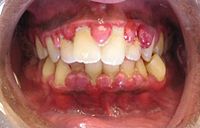
Photo from wikipedia
OBJECTIVE Probiotics are usually given as living cells, but their effects may be also achieved by postbiotics. We hypothesized that probiotics products (spent media and lysate) altered the response induced… Click to show full abstract
OBJECTIVE Probiotics are usually given as living cells, but their effects may be also achieved by postbiotics. We hypothesized that probiotics products (spent media and lysate) altered the response induced by P. gingivalis in gingival epithelial cells (GECS). METHODS Immortalized human OBA-9 GECs (∼2,5 × 105cells/well) were challenged with P. gingivalis ATCC33277, and co-infected with L. rhamnosus Lr-32 for 4 h. L. rhamnosus Lr-32 spent medium or cells lysate was added to GECs co-infected with P. gingivalis. Another set of OBA-9 GECs were first exposed to P. gingivalis ATCC 33277 and then to the living probiotic or probiotic products. Transcription of genes encoding inflammatory mediators (IL-1β, TNF-α, IL-6, and CXCL-8) and receptors (TLR2 and TLR4) were evaluated by RT-qPCR. P. gingivalis growth under L. rhamnosus Lr-32 postbiotics was also evaluated. RESULTS L. rhamnosus Lr-32 spent media decreased cell viability, while living cells and cell lysates did not. L. rhamnosus Lr-32 lysate, but not spent media, upregulated transcription of inflammatory mediators (IL-1β, TNF-α, IL-6, and CXCL-8) in GECs infected with P. gingivalis. Transcription of TRL2 was upregulated in all experimental groups compared to control, whereas TLR4 was upregulated by the probiotic or its postbiotics in P. gingivalis infected cells. Spent media and lysates reduced the growth of P. gingivalis. CONCLUSION L. rhamnosus Lr-32 cell components rather than live probiotic enhanced the expression of inflammatory mediators in P. gingivalis infected gingival epithelial cells. The increased potential of Lr-32 cell lysates to promote immune response to the periodontopathogen may favor pathogen elimination but may also lead to additional deleterious effects of the exacerbated inflammation.
Journal Title: Archives of oral biology
Year Published: 2021
Link to full text (if available)
Share on Social Media: Sign Up to like & get
recommendations!